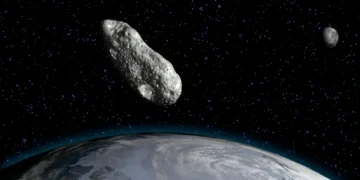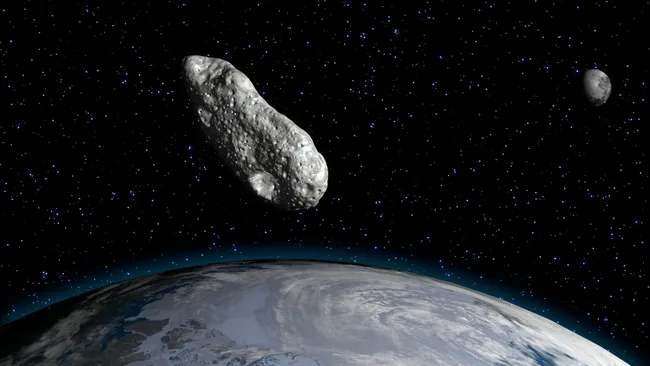In the ever-changing dynamics of our cosmic neighborhood, Earth’s gravitational field occasionally captures small celestial objects, creating temporary moons known as “minimoons.” These rare and transient companions provide a unique glimpse into the interactions between Earth and its surrounding space. The recent discovery of asteroid 2024 PT5 has sparked widespread intrigue, with researchers hypothesizing that this minimoon may have originated from the Moon itself, catapulted into space by ancient collisions. However, with its departure imminent, the opportunity to study its origins is slipping away—an event as fleeting as the minimoon’s orbit.
What Are Minimoons, and Why Do They Matter?
Minimoons are celestial objects, typically asteroids, that are temporarily captured by Earth’s gravity. Unlike quasi-moons, which orbit the Sun alongside Earth and occasionally interact with our planet, minimoons are short-term visitors, usually staying for just a few months. The phenomenon is rare but not unprecedented; 2024 PT5 marks only the fifth confirmed minimoon in history.
The rarity of these cosmic guests makes each discovery significant. Minimoons offer scientists a chance to study Earth’s gravitational influence in real time and provide insights into the broader dynamics of our solar system. They also serve as potential testing grounds for future space exploration, including resource storage and interplanetary travel.
The Discovery of 2024 PT5: A Rare Celestial Encounter
Discovered in early September 2024, 2024 PT5 was identified as a small asteroid, approximately 33 feet (10 meters) in diameter. Its capture into Earth’s orbit began on September 29, creating a temporary loop around our planet. By the time it escapes Earth’s gravitational grip on November 25, the minimoon will have completed only about one-quarter of a full orbit, reaching a maximum distance of 2.3 million miles (3.7 million kilometers) from Earth—roughly 9.5 times the distance to the Moon.
The discovery was made possible through the combined efforts of astronomers using advanced telescopes in the Canary Islands. Observations revealed that the minimoon spins around its axis once every hour, adding a layer of complexity to its study. These findings have set the stage for one of the most intriguing hypotheses about its origin.
A Lunar Connection? Evidence of a Shared Origin with the Moon
What makes 2024 PT5 particularly fascinating is the hypothesis that it may have originated as lunar ejecta—a fragment of the Moon itself, hurled into space by a massive meteorite impact millions of years ago. Researchers analyzing the light reflected from the minimoon found striking similarities to “lunar ejecta,” the material expelled from the Moon during such collisions.
This theory places 2024 PT5 in a unique context, suggesting that it may belong to a broader family of celestial objects, including the quasi-moon Kamo’oalewa, which has been traveling alongside Earth since 2016. Both objects exhibit characteristics consistent with lunar debris, strengthening the case for their shared origin. However, due to the limited observational window, the evidence remains inconclusive.
The Challenges of Studying Minimoons
The fleeting nature of minimoons presents significant challenges for researchers. In the case of 2024 PT5, its departure from Earth’s orbit limits the time available for detailed observations. After November 25, the minimoon will drift away, not returning for another close approach until January 2025, followed by distant passes in 2055 and 2084.
This temporal constraint makes it difficult to collect the comprehensive data needed to confirm its lunar origin. Advanced technologies, such as high-resolution spectroscopy, could potentially provide definitive answers, but only if future observations align with the minimoon’s sporadic returns.
What 2024 PT5 Teaches Us About Earth’s Gravitational Neighborhood
The study of 2024 PT5 offers valuable lessons about Earth’s gravitational interactions and the dynamics of near-Earth space. By analyzing its trajectory and composition, scientists can refine their understanding of how Earth captures and releases such objects. This knowledge has broader implications for planetary defense, space exploration, and even the search for extraterrestrial resources.
Minimoons like 2024 PT5 are more common than previously thought, but advancements in detection technology are only now allowing us to identify them. As our capabilities improve, the study of these transient celestial objects will likely become a focal point in understanding the intricate dance of gravity that governs our solar system.
The Broader Implications for Space Exploration
Beyond their scientific value, minimoons hold promise for practical applications in space exploration. Their proximity to Earth makes them ideal candidates for missions involving resource extraction, such as mining for water or metals. Additionally, they could serve as supply depots or staging points for missions to more distant destinations, reducing the logistical challenges of interplanetary travel.
The discovery of 2024 PT5 underscores the need to prioritize the study of such objects. By understanding their composition and behavior, we can unlock new possibilities for sustainable space exploration and move closer to becoming an interplanetary species.
A Glimpse into the Future: What’s Next for 2024 PT5?
As 2024 PT5 prepares to leave Earth’s orbit, researchers are left with more questions than answers. Its brief stay has provided a tantalizing glimpse into the mysteries of our celestial neighborhood, but the full story remains elusive. Future advancements in observational technology and international collaboration will be essential to unraveling its secrets.
The minimoon’s next close approach in January 2025 offers a potential opportunity for further study, though its fleeting nature will once again pose challenges. Long-term tracking and analysis will be crucial to confirming its origins and understanding its place within the broader family of near-Earth objects.
Conclusion: Why 2024 PT5 Matters
The discovery of 2024 PT5 is a reminder of the dynamic and interconnected nature of our cosmic environment. Whether it originated from the Moon or elsewhere, its journey offers valuable insights into the forces that shape our solar system. As we continue to explore and understand these transient visitors, we not only deepen our knowledge of the universe but also pave the way for humanity’s future in space. The minimoon’s story may be brief, but its impact on our understanding of Earth’s gravitational relationships will resonate for years to come. As it drifts away, it leaves behind a legacy of curiosity and discovery—a testament to the boundless possibilities of exploring the unknown.
Reference:
Basaltic mini-moon: Characterizing 2024 PT5 with the 10.4 m Gran Telescopio Canarias and the Two-meter Twin Telescope
R. de la Fuente Marcos, J. de León, M. Serra-Ricart, C. de la Fuente Marcos, M. R. Alarcon, J. Licandro, S. Geier, A. Tejero, A. Perez Romero, F. Perez-Toledo, A. Cabrera-Lavers



















